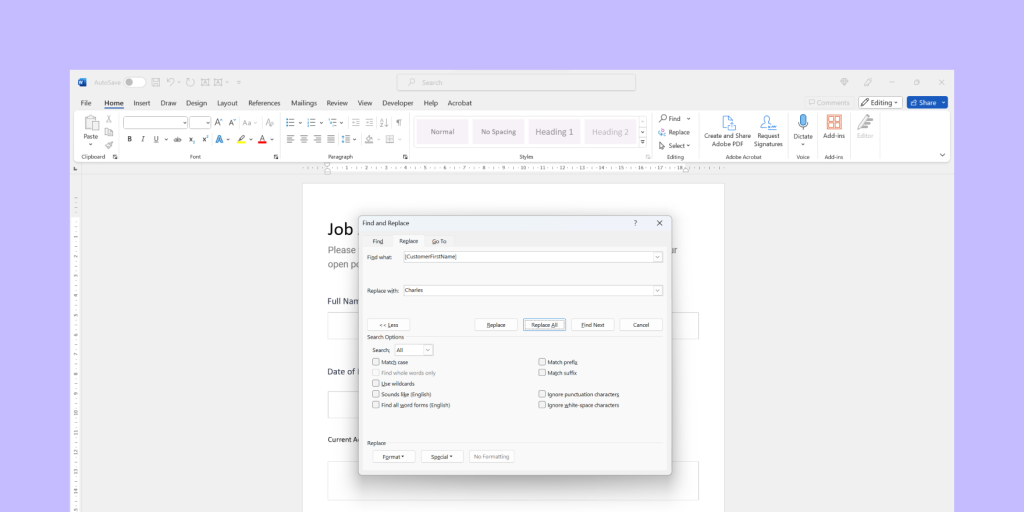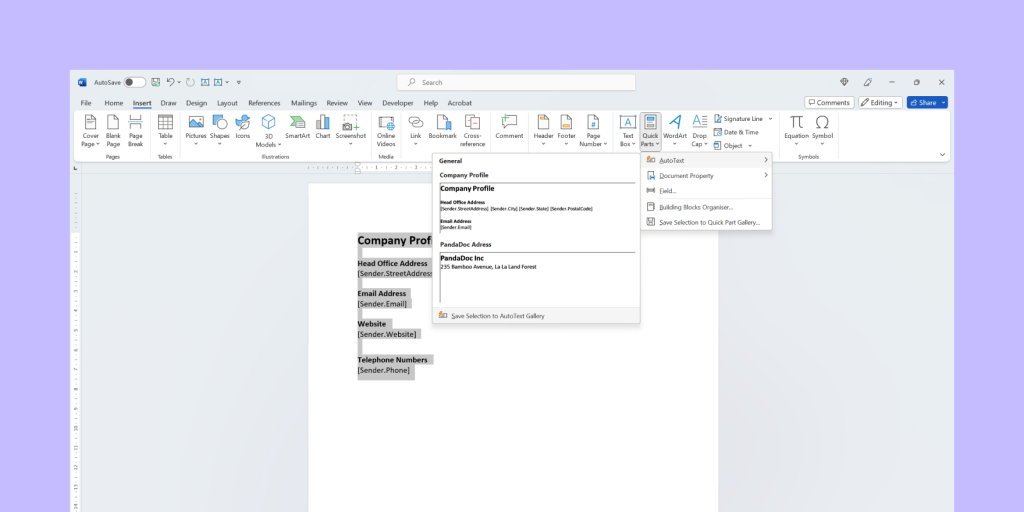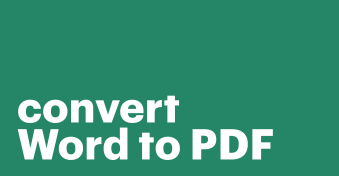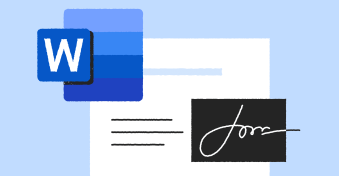Microsoft Word is essential for creating documents that organizations use every single day.
While some of these documents will be unique, most companies end up with a small template library for their most commonly used documents.
Why? Because it’s easier to duplicate an approved contract and fill in the blanks rather than spend time writing something entirely new from scratch!
And that’s just one example of automation using MS Word.
In this article, we’re going to cover 7 ways that you can save even more time by automating Word documents to suit your needs.
Let’s jump in.
Key takeaways
- Microsoft Word is a powerful document creation tool with several built-in automation options for users with varying levels of experience.
- There are a variety of ways to automate Word documents. However, depending on your setup, some methods may be more effective than others.
- Word, while a capable document generator, isn’t the best platform for everything. Sometimes, it’s best to rely on other tools instead.
1. Use find/replace shortcut tools
Available on: Windows, macOS, Web.
What does it do? Allows you to quickly identify variables using the find and replace tool.
Skill required: None.
Great for: Form and document creation.
One of the most common ways to automate document production is to save a document template and use the find and replace feature in Microsoft Word to locate variables that require substitution.

While this method largely requires hands-on, manual control, it’s popular in many companies because it doesn’t require macros, add-ins, or code-based automations that can add vulnerabilities within the corporate security network.
With this approach, you’ll need to create variables or blank spaces within your document to be filled at a later date.
This is a standard procedure for boilerplate contracts, and the level of automation using this method is determined by the specificity of the variables you designate.
For example, if you create variables like [CustomerFirstName] and [CustomerLastName] within your document, you could use the find and replace workflow to quickly adjust these names based on contract recipients.
Quick note: This is also how we handle variables at PandaDoc.
On the other hand, if you only use blank lines when creating your template (i.e: This contract between Your Company and _______ ensures that…), you’ll have great flexibility during the replacement stage, but filling details becomes a more intensive process.
2. Use quick parts and autotext

Available on: Windows, macOS.
What does it do? Allows users to create insertable text snippets and other reusable pieces of content.
Skill required: Low.
Great for: Document creation.
Found under the Insert tab in MS Word and MS Outlook, Quick Parts is Microsoft’s offering for users who want to create a clause or snippet library.
Quick Parts is just the category. The actual tool you’re looking for is called AutoText.
For Mac users: AutoText still exists in the Insert menu and accomplishes the same thing without the additional navigation requirements.
In short, AutoText allows you to create content snippets that you can use over and over again.
It’s similar to our very own content library feature, though it’s not as robust.
Quick Parts allows you to save your AutoText as part of a gallery that can be used to insert blocks of text directly into your document.
This could be used for something as simple, like an address block for a document header.
You might also use it to insert more complex, conditional snippets into your sales proposals or legal documents.
It’s an interesting feature that requires only minimal setup, so it’s great for users who have limited technical skills or restricted capabilities when creating automated file content.
Unfortunately, Quick Parts comes with a few downsides.
They’re only saved locally, meaning that you’ll need to transfer them manually to a new computer if you want to use them elsewhere.
Sharing your Quick Parts can also be an issue.
Some offices create Quick Parts exclusively in their shared document library (through OneDrive) so that anyone using the template has access to the entire Quick Parts library.
However, compared to alternative solutions, the system feels like a rudimentary or ad-hoc solution to an actual content database.
If creating a shared content library appeals to you, using platforms like PandaDoc or shared snippet automators like TextExpander are probably the way to go.
3. Use the developer tab
Available on: Windows, macOS.
What does it do? Allows document creators to create templates while restricting editorial access to specific elements.
Skill required: Moderate.
Great for: Form creation.
The Developer tab is an Office feature that allows you to change and modify the functionality of your Microsoft Word documents.
Although it’s hidden by default, it’s possible to reveal the Developer tab on your Microsoft Office ribbon with just a few clicks.
The features you’ll find in the Developer tab will be most useful for creating fillable forms within Microsoft Office.
To do this, you can create files using your standard workflow.
Add questions and leave blanks or variables in place during document creation.
When you’re done, use the Developer tab to restrict editing to specific fields.
You can then send those Word files to other users so that they can fill out the form.
The Developer tab also gives you added functionality by allowing you to insert various content and properties, including date pickers, dropdown lists, check boxes, and more.
You can learn more about everything this feature has to offer by using this support link.
4. Use a macro
Available on: Windows, macOS.
What does it do? Allows users to create and execute small snippets of code that replicate user actions.
Skill required: Moderate.
Great for: Creating complex, one-click workflows using keystrokes and onboard variables.
If you’re looking for a way to quickly populate documents and templates with specific information, macros can be a great way to do it.
Macros function by recording keystrokes and then repeating those keystrokes back in the same way they were recorded.
This allows users to create complex macros that can do everything from filling out basic forms to generating entire documents using complex logic.
To get started with macros, you’ll need to customize your ribbon and enable the Developer tab.
From there, you can begin the process of recording macros and streamlining your entire document workflow.
You can even save macros to templates, so users creating new Word documents from those templates will have access to the same selection of macros.
Keep in mind that macro creation isn’t limited to text.
You could use it to create images, custom tables, reformat your document layout, and much more. In many ways, the sky’s the limit.
Unfortunately, because of their flexibility, macros can also be used as an entry point for malware.
As a result, this functionality is often disabled in corporate environments.
5. Automate using Visual Basic (VBA)
Available on: Windows, macOS, Web.
What does it do? Allows tech savvy users to create powerful automations using an event-driven programming language.
Skill required: Complex.
Great for: All document automation.
Visual Basic for Applications is an event-driven programming language native to most Office applications using Windows API tools.
It’s possible to use VBA for both individual applications or across the entire Office suite (not just Word, Excel, and PowerPoint).
Particularly with Word, VBA relies on using document bookmarks to define where information should be placed or modified with VBA instructions.
With that in mind, it’s possible to create an automation protocol using VBA where data gathered from Excel spreadsheets are inserted into Word documents with a click.
How would that work?
First, you’d need to define a template within Word with variables or properties using bookmarks.
Then, using Excel, you could create a form that customers fill out and return with appropriate information.
From there, you could use VBA to import that data directly from the spreadsheet into the appropriately matched fields and finalize the document automatically.
And that’s just a taste of what VBA can do.
Unfortunately, mastering VBA isn’t as easy as creating simple macros.
This framework can be used to create powerful processes, but it requires a deeper understanding of the Visual Basic programming language.
Without that knowledge, taking advantage of VBA and everything it has to offer may simply be out of reach.
6. Use an app or add-in
Available on: Varies (depends on add-in).
What does it do? Varies (depends on the add-in).
Skill required: Low.
Great for: Document creation, e-signing, reference lookup, and more.
Sometimes, automation doesn’t come from modifying Word at all.
Often, it’s better to use a connector app or add-in to bring in additional information or add new functionality to your Word documents.
For example, rather than creating complex code to import data from an Excel spreadsheet — as you might have done with Visual Basic — you could connect Word to a CRM like HubSpot and simply import the relevant data into your templates.
In most cases, you won’t need to learn complex code, navigate through a ton of tutorials, or fight with convoluted backend systems.
Instead, these solutions are mostly plug and play.
The functionality provided by these add-ins will be determined by their intended functionality.
For example, it’s possible to use our PandaDoc for Microsoft Word add-in to enable electronic signature capture on any Word document.
You can find a wide selection of apps and add-ins through AppSource, the Microsoft-run repository for all Office apps and extensions.
You could also use a tool like Make to create custom integrations that automatically generate new Word documents and add appropriate details based on a given ruleset.
7. Export from Word to other solutions
Available on: Windows, macOS, Web.
What does it do? Varies (depends on the add-in).
Skill required: Low.
Great for: Next-level document creation, customization, and distribution.
At the end of the day, Microsoft Word is a word processor.
It’s great for some things (writing documents), but terrible at other things (document design, sharing and distribution, etc.)
Despite Microsoft’s best attempts to create a unified word processing and desktop publishing platform, most users find those results lacking.
The same is true when it comes to sharing, collaboration, e-signature capture, and more.
Word is a great starting point for so many essential document-related tasks, but it’s often not the greatest endpoint or final solution.
In situations where you need to do something else with your documents, one of the easiest ways to automate your process is to simply export your content from Word to another tool.
Use Word to create the basic template before finalizing in another software solution farther down the road.
The actual solution you need will vary greatly depending on your desired outcome.
For example, importing to a platform like PandaDoc makes sense if you need to format a document for proposal and signature capture.
On the other hand, you might want to import your Word document template into something like Canva if you need robust and easy-to-use design tools.
This approach is more open-ended, but it will be the best solution for automating Word documents in many scenarios.
Bonus: Use Power Automate to create automated workflows
Power Automate is part of the Microsoft Power Platform, which includes a variety of other key tools (Power Apps, Power Pages, Power BI, etc.) for business users.
While it’s not specific to Microsoft Word, Power Automate allows you to streamline repetitive tasks within your workflow by creating actions that execute automatically whenever a condition is met.
For example, you could set up a dedicated inbox to receive a form, then create a Power Automate flow to trigger the creation of a Word document where the form data is automatically added to a predefined document template.
If you’re deeply integrated into the Microsoft suite, using Power Automate can extend the reach of your documents in a way that goes beyond pop-ups, dropdowns, and basic integrations.
Level up your automation process with PandaDoc
No matter how you look at it, automating Word documents can be a major challenge.
Rather than dealing with complex Microsoft Word template actions, confusing file names, or fighting with plain text content controls, it might be best to take a step back and see if you can find a better solution.
PandaDoc offers from-scratch document creation that is built for online sharing and collaboration.
Our onboard document builder allows for intuitive document design, e-signature capture, and content automation that can be scaled across thousands of users.
It’s a system designed with one-click automations using templates, text snippets, and plug-and-play page design.
Give PandaDoc a try today with a free 14-day trial or sign up for a personalized demo and one of our experts will walk you through the details.
Disclaimer
PandaDoc is not a law firm, or a substitute for an attorney or law firm. This page is not intended to and does not provide legal advice. Should you have legal questions on the validity of e-signatures or digital signatures and the enforceability thereof, please consult with an attorney or law firm. Use of PandaDocs services are governed by our Terms of Use and Privacy Policy.


